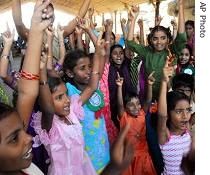2006年VOA标准英语-Study Says India Has Fewer HIV Infections Than(在线收听)
New Delhi
17 December 2006
A recent study suggests that the number of people afflicted with HIV/AIDS in India could be far lower than current estimates. The United Nations says India has 5.7 million people living with the AIDS virus, the highest number in the world. But as Anjana Pasricha reports from New Delhi, the real number might be only half of that.

HIV affected children in a festive mood at a function in Hyderabad, 7 Dec 2006
Ever since the first AIDS case was diagnosed in India 20 years ago, there has been a heated debate over how many people in this massive country are affected by HIV, the AIDS virus.
Voluntary groups frequently accuse government officials of downplaying the problem, and maintain that the number far exceeds the official estimate of 5.7 million.
The United Nations bases that figure on information from the Indian government, and calls it the largest number of cases in the world. Some years ago, in a widely cited prediction, the U.S. Central Intelligence Agency said the number of HIV-positive people in India could swell to 20 million by 2010.
But a new study published in the British medical journal BMC Medicine says these numbers could be gross overestimates. The actual number at present, the study suggests, might be less than half the official figure.
The study was conducted by the Administrative Staff College of India in Hyderabad, a well-known research and consultancy group. It was carried out in the Guntur district of Andhra Pradesh province, which is one of the areas of the country worst hit by HIV.
The researchers say they followed a different method from the government: they tested individuals one by one, while the government bases its figures on data collected from pre-natal clinics, sexual health clinics and public hospitals.
Lalit Dandona, who headed the study, says the government method gives a flawed picture. He says one reason might be that the clinics are used by the segment of society in which HIV is most prevalent.
"The profile of the women using ante-natal clinics in the public sector is not representative of the population," he said. "And secondly, the public-sector hospitals are used disproportionately higher by the lower socio-economic strata, which in our study had a higher HIV rate. So these two reasons combined lead to an artificially inflated HIV rate if it is directly applied to the entire population."
Dandona says the discrepancy stood out starkly in Guntur. The researchers collected about 12,000 blood samples from young men and women there. From this, they estimated that there were 45,900 people living with HIV in Guntur - less than half the 112,600 suggested by the official method.
The United Nations AIDS chief in India, Denis Broun, calls it a good study, but says it is too early to tell whether it is valid for India's entire billion-plus population.
"It has good methodology, it has a good size of the sample and the quality of the study is great," said Broun. "We are a little more concerned about the conclusions, which are drawn from it. It is difficult to draw conclusions from one district and apply them to the whole of India."
There would be some precedent for a revised figure. In the past, the U.N.'s HIV figures for some African countries were found to be overestimated, and were revised downwards.